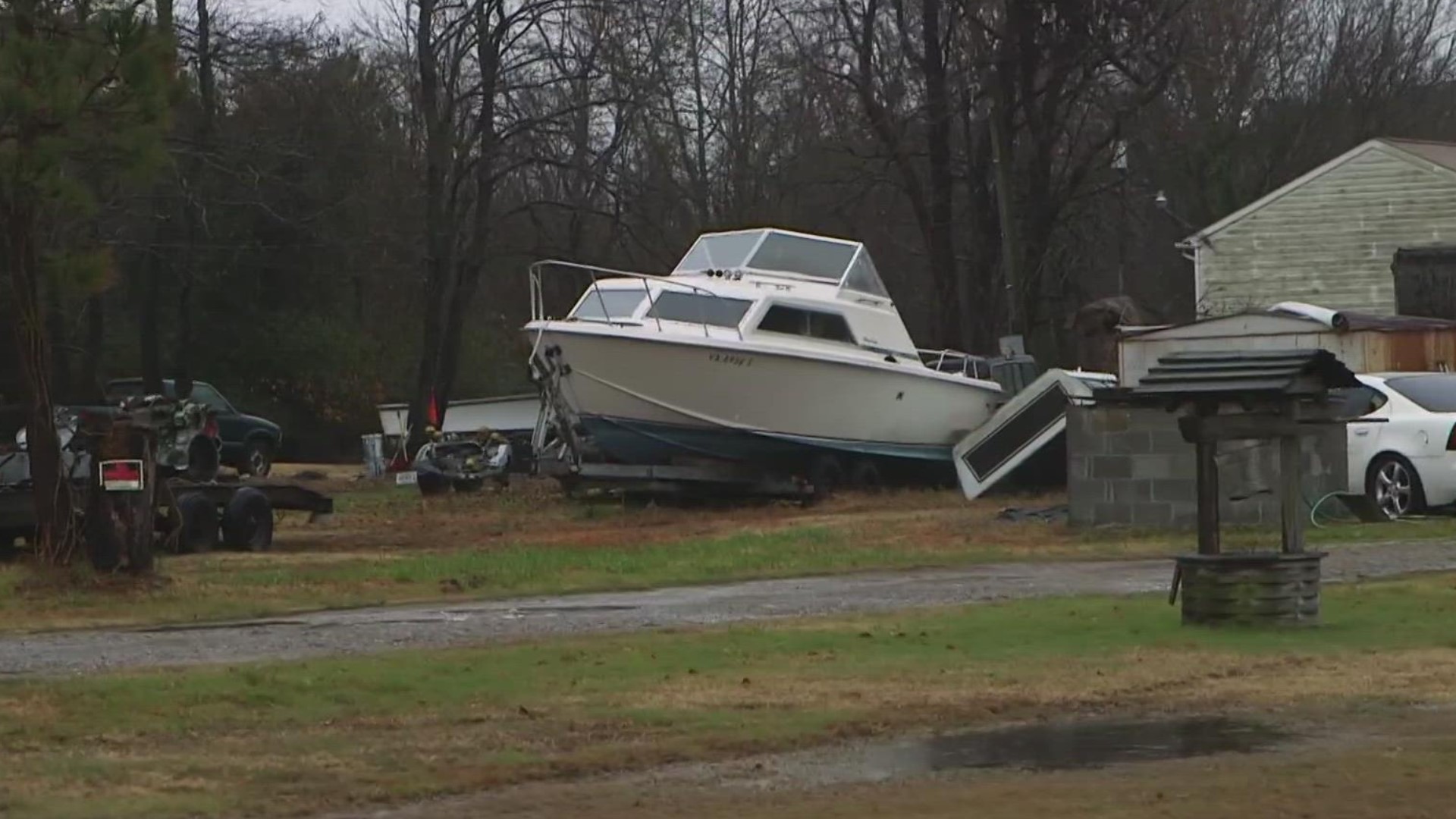GLOUCESTER COUNTY, Va. — Some people have a special connection with the water.
It's why 83-year-old retired waterman Kenny Man Kellum will always call the Guinea community of Gloucester County his home.
"I've always worked on the water, all my life," he said. "And, I love fishing. I've crabbed, I've oystered. You name it on the water, I've done it."
But that special connection may also be the biggest challenge about the place he loves so much.
The first floor of his house isn't at ground level. In the aftermath of Hurricane Isabel in 2003, storm surge brought almost two feet of standing water inside. With the help of FEMA, his home was rebuilt and raised 8 feet and 4 inches off the ground.
His standing home is now one of many in the Guinea area. That and the flooding in his front yard regularly remind him of the water's closeness.
Both serve as a standing reminder of the burdens sea level rise puts on Virginia's more rural communities, where flooding and coastal erosion affect fewer people, are less visible on a large scale, and often come at a higher cost to the individual.
Guinea's unique geography
Coastal flooding is common across the Hampton Roads region. Data from the National Oceanic and Atmospheric Administration show sea levels at Sewell's Point are up roughly eight inches since 1970.
"It's been rising that entire time, but it's been rising faster in recent history," said Molly Mitchell, a marsh ecologist with the Virginia Institute of Marine Sciences. "The high years are higher than they used to be, and the low years are higher than they used to be."
Underwater roads and intersections are easy to spot during flooding events in urban areas, like Norfolk and Virginia Beach. But these issues are felt on a different scale, depending on where you live.
Mitchell said Guinea's unique geographic location factors into the toll sea level rise is taking on the community. With a population density of roughly one-third of the region's urban centers, Guinea sits on the right side of what's called the "Suffolk Scarp."
Deep underground, the scarp is a steep slope that marks an old sand dune ridge. It extends in line along the East Coast from Suffolk to near Morehead City, North Carolina. Guinea being located on the terrace to the east of the Suffolk Scarp places the area even closer to sea level, making it more susceptible to flooding.
"The hours of flooding have increased dramatically," Mitchell said. "Not that flood events are necessarily longer, but that you're just getting a lot more."
Changes in tide, changes in land
Guinea sits at the mouth of the Chesapeake Bay with long, extended marshes.
Since marshes don't change in elevation, Mitchell said a relatively small amount of water can flood a larger area. Over time, the rising tide cuts deeper and deeper into the land, changing the ecology of the area.
The marsh, she said, is moving inland. And that movement across the landscape is accelerating.
This has created what some call "ghost forests," areas where the forest lining the back edge of the marsh starts to die as the marsh migrates inland, leaving behind dead trees.
But it's not just the forests that are being affected.
"There are a lot of places you can walk back in the woods here and see old corn rows," said Walter Priest, a retired marine scientist specialized in wetlands biology.
Having lived in Guinea since the 1970s, he's watched sea level rise change the area's agricultural layout, as the moving marsh line disrupts Guinea's old farmland.
"Some of those areas are starting to get inundated to the point where they can no longer grow crops on them," he said. "It's a combination of the actual flooding and the salt residue that's left in the soil."
Both are examples of how tidal changes, even if imperceptible on a day-to-day basis, can gradually change the surrounding environment.
Individual vs collective burdens
Guinea is a prime example of the different challenges sea level rise brings to rural communities versus more urban areas.
In areas with higher population density, there's the potential for a lot of impact from any amount of flooding. But residents there also benefit from a lot of public infrastructure.
"If a drinking water plant were to start to become salinized, that's a public piece of infrastructure," Mitchell said. "And so there's a public entity that's responsible for it, and so they do upgrades, and maybe they have to raise rates a little bit, but the burden is shared across everybody."
She added: "If an individual's well becomes brackish, they pay to dig a new well."
In Guinea, the burden of coastal resiliency often falls on the individual rather than the collective community.
“In the rural areas, people are spread out, so flooding maybe impacts fewer people, but you have individual septic systems or private wells," Mitchell said. "People are individually being impacted, and there is no centralized way sometimes to deal with the flooding."
According to data from the Virginia Department of Emergency Management, the county has raised roughly 50 homes in the Guinea area over the last 20 years using FEMA grants. There are four active grants right now and 15 homes that still need to go through the process.
"You can elevate a house to make sure a house isn't going to flood, but a septic system is still in the ground, electricity might run through pipes in the ground, water supply, well water, is vulnerable to flooding," Mitchell said.
But people born in Guinea are fiercely loyal to it, even if it's changing under their feet. Long-time residents are adjusting their lives to the environment so they can stay in this waterside community.
For Kellum, he said it's the prettiest place he's ever been in his life.
"People say the water is dangerous," he said. "Oh yes, but it can be friendly to you, too."

